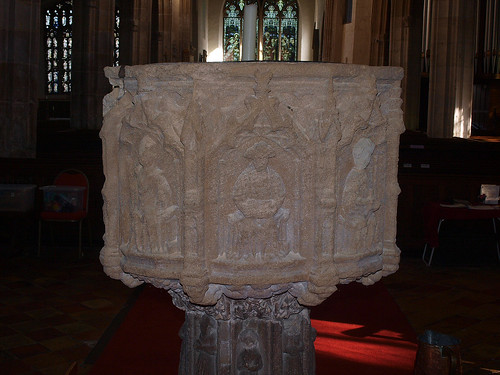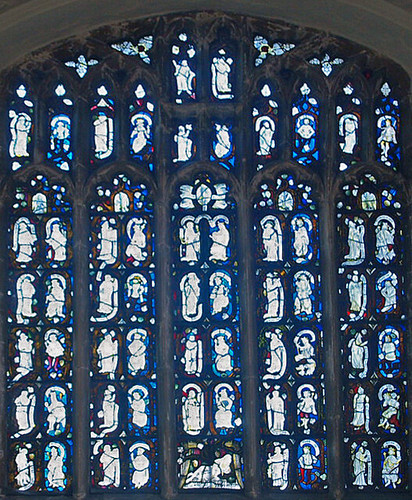ST LEONARD. The W tower of Leverington is one of the most impressive in the county. The lower parts are all E.E. The tower arch towards the nave has stiff-leaf capitals. The W doorway is enriched by one order of colonnettes, and a gable with a small trefoiled figure niche below. Then there are lancet windows, tall blank arcades with shafts and shaftrings and big polygonal clasping buttresses as at Elm. Only at the stage of the bell-openings does the Dec style take over. It continued with the battlements, the four recessed polygonal turret-pinnacles and the spire, 162 ft high, with three tiers of dormers (rebuilt 1901). Next comes the chancel, late C13 probably, see its excellent E window with a window in the form of a spheric triangle above, and the two tall quatrefoil piers separating the chancel from the S chapel. The chapel, however, must have been rebuilt early in the C14; for it has an equally excellent E window with flowing tracery. Of the same period probably the S aisle wall and the S porch, the most ornate piece of architecture belonging to the Church. It is two-storeyed and has an ogee-headed doorway with niches l. and r., and on the ground floor two bays, each with two-light openings. The vault is in two bays too, with a ridge-rib and bosses. The ribs rest on thin wall-shafts with castellated capitals. The Perp style of the C15 was responsible for the nave arcades and clerestory, most aisle windows, the chancel arch and the chancel N and S windows. The latter are tall with one transom; the arcades have slim piers much deeper in a N-S direction than they are wide, and with capitals only towards the arch openings. The original roof rises high up on stone-corbels and has tiebeams with much tracery. Below it the restoration of 1901 put in another set of tiebeams on thickly foliated corbels. - FONT. Octagonal, Perp, with small standing figures against the stem and large seated figures under ogee arches on the bowl; one of the best medieval fonts of Cambridgeshire. - LECTERN, oak, late C15, as usual with the figure of an eagle. - STAINED GLASS Jesse Window, N aisle E, C15, the most important in the county, outside Cambridge; 61 figures of which 13 are completely original and 17 restored; the rest C19 and C20. The figures are in oval medallions formed by vine scrolls. They hold scrolls. The impression is one of great opulence and warmth. - In the S chapel E window C15 kneeling donors (Sir Laurence Everard and Dame Margaret Colville) and a Pieta; not originally belonging to the church. - MONUMENTS. Spelman Swaine d 1761, and Spelman Swaine d 1803 both prettily done with various marbles; in the older a standing putto leaning on an urn, against a grey obelisk; in the later a seated figure against a pink obelisk.
LEVERINGTON. We found a windmill still working in this pleasant spreading place among the orchards, and beauty and interest in abundance safe in the medieval church. So lovely is its ribbed spire, rising to a height of 162 feet on a majestic tower, that when it showed signs of wear after 700 years it was rebuilt stone for stone with all its dainty gabled lights. The tower and its spire are masterpieces from the l3th century; the two-storeyed porch is a masterpiece from the 14th. It has a pierced crest of wavy carving along its gable ridge, with stepped buttresses niched for statues, heads on its vaulted roof, embattled columns between its four windows, and old doors with a wicket through which we enter.
The doors open into a nave with graceful arcades from the 15th century, a beautiful leafy tower arch, and a font in isolated loveliness. It is one of the best 15th century fonts, with eight saints seated under canopies round the bowl, angels under the bowl, and eight figures standing round the stem, while odd corners are filled with flowers and animal heads. A lofty 15th century tower arch opens into the chancel, and above the old door to the vanished roodloft are stone heads of Edward the Third and his Queen Phillipa. The sedilia and the three arches opening to the side chapel are 13th century. Stone corbels look down from the roofs, a woman in a horned headdress and a demon among the old ones, queens and clerics among the new. The stout altar rails are Jacobean, and there is a curious old oak lectern with six lions crouching below an eagle painted red and gold.
Flowing medieval tracery fills the east windows of the chancel and the chapel, and the third east window has a Jesse tree in 15th century glass, brilliantly restored at the end of the last century. The branches curl round over 60 figures in white and gold, and half of them are original. In a chancel window is more fine old glass given by Sir Lawrence Colville 500 years ago. His arms are here and a picture of Our Lady of Pity mourning the Son lying on her lap, while round them kneel knights and ladies praying. There is more medieval glass with saints under canopies in another chancel window.
A queer and familiar name looks out from a wall memorial here to Captain Anthony Lumpkin, who died in 1780, seven years after Oliver Goldsmith had produced She Stoops to Conquer. It is said that Goldsmith stayed with his friends the Lumpkins here and it is considered probable that he took the name of Tony Lumpkin from Anthony. The suggestion has been made that he may have written some of the play under the village mulberry tree, and it is curiously interesting to reflect that the captain named on these walls may perhaps have been the original of Tony Lumpkin whose figure has so long been familiar to us on the stage.
The doors open into a nave with graceful arcades from the 15th century, a beautiful leafy tower arch, and a font in isolated loveliness. It is one of the best 15th century fonts, with eight saints seated under canopies round the bowl, angels under the bowl, and eight figures standing round the stem, while odd corners are filled with flowers and animal heads. A lofty 15th century tower arch opens into the chancel, and above the old door to the vanished roodloft are stone heads of Edward the Third and his Queen Phillipa. The sedilia and the three arches opening to the side chapel are 13th century. Stone corbels look down from the roofs, a woman in a horned headdress and a demon among the old ones, queens and clerics among the new. The stout altar rails are Jacobean, and there is a curious old oak lectern with six lions crouching below an eagle painted red and gold.
Flowing medieval tracery fills the east windows of the chancel and the chapel, and the third east window has a Jesse tree in 15th century glass, brilliantly restored at the end of the last century. The branches curl round over 60 figures in white and gold, and half of them are original. In a chancel window is more fine old glass given by Sir Lawrence Colville 500 years ago. His arms are here and a picture of Our Lady of Pity mourning the Son lying on her lap, while round them kneel knights and ladies praying. There is more medieval glass with saints under canopies in another chancel window.
A queer and familiar name looks out from a wall memorial here to Captain Anthony Lumpkin, who died in 1780, seven years after Oliver Goldsmith had produced She Stoops to Conquer. It is said that Goldsmith stayed with his friends the Lumpkins here and it is considered probable that he took the name of Tony Lumpkin from Anthony. The suggestion has been made that he may have written some of the play under the village mulberry tree, and it is curiously interesting to reflect that the captain named on these walls may perhaps have been the original of Tony Lumpkin whose figure has so long been familiar to us on the stage.



No comments:
Post a Comment